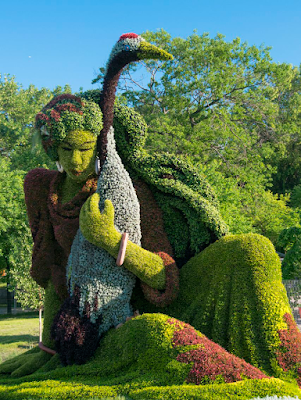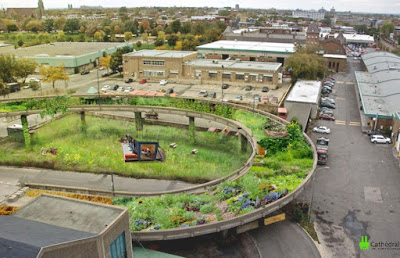The Magical Home was the theme of a magazine I read on the flight from Connecticut to Montréal. In one column, the writer* describes Hestia, goddess of the hearth, in a way I’d never considered.
I will tell you the truth about Hestia: She is dangerous to the Patriarchy, to capitalism, to the industrial rape of the world. She is a Goddess fomenting a revolution; and devotion to Her can be an act of radical politics.
The writer asserts that, although our culture has consigned Hestia to the kitchen and to silence, Hestia’s realm actually extends beyond house and garden. According to her, Hestia is a goddess of the larger places we inhabit. She is the heart of each of those places and she cultivates the web of relationships that constitutes them.
 |
| Enormous horticultural sculpture, at the Montréal Botanical Gardens (in 2013) |
If you believe that home means more than a single-family dwelling, your homemaking will naturally have a broader impact. Hestia could inspire people to know and take care of their neighborhoods and the beings that inhabit them—people, animals, plants, rivers…
Hestia’s devotees talk to their neighbors, buy their food from local farmers, lobby for clean water and affordable housing, protest injustice even when the cops wear armor, rescue animals, and stand up for the “underprivileged.” They value the place in which they live; they value all the beings that dwell there.
Patriarchy can’t have that; it needs us to be interchangeable cogs: willing to move anywhere for a better job, a new job, or, more and more these days, any job. It prefers us to be fungible and to regard one home as just as good as another. But Hestia says, “Your place matters. Your local relationships matter. You are not fungible; your place is not fungible; the home of your heart is important.”
The writer rejects the image of Hestia as a “retiring maiden quietly tending the home fires.” I thought Hestia’s empowerment evaporated outside the walls of her home. While she might step outside her house for a brief venture into quiet, rural community, I couldn’t imagine her thriving in the bewildering chaos of a city, a place that exemplifies alienation.
Hestia needs to be present, centered, and in relationship. In cities, the pace of existence has accelerated to suit business. The ways people relate to each other have been diminished and warped. Concrete covers land where forests once grew or herds of animals once roamed, and enough concrete can even change weather patterns. Indoor woman though she is, being totally cut off from nature would damage Hestia.
While the column was interesting, I couldn’t imagine Hestia as a goddess of a city until I visited Montréal two weeks ago.
My second night in Montréal, my friends took me to the top of Mont Royal to admire the view. The lights and the river were beautiful, but not what I’d expected. Without thinking, I exclaimed, “It’s not a city, it’s a place!” It wasn’t a meaningless statement; the expanse of lights below seemed warm and gentle rather than impressive and alienating.
 |
| My friend and me by the St. Lawrence River near Old Montréal, photo by Pierre Ouimet (June 2015) |
Perhaps I perceived Montréal that way because I had already met the city, down there, close up. Pierre and Céline had introduced me to some of Montréal’s people and communities, landmarks, neighborhoods… and locally brewed beers. (I recommend the bière pamplemousse.) My friends are socially conscious and sociable, so I had seen Montréal in the best light.
My memories of wonderful days there are somewhat jumbled. In no particular order, I’ll describe a few of them.
You meet friends on the street. That morning, we had walked from their apartment to their community garden. In just a couple of blocks, they had greeted and stopped to chat with half a dozen people they knew. (In my small town, my friends and I have wondered why we never run into people we know when we're out and about.)
The city is child-friendly and tree-friendly. There were parks everywhere and children playing in them! On weekdays, people were relaxing and enjoying each other’s company on expanses of green. There was a lot of music, too. We walked through Old Montréal and along the river. The metro conveniently transported us to various parts of the city.
Residents transform the city with horticulture. Another morning, Céline took me through alleys that people have turned into gardens and we planted tomatoes between a sidewalk and a curb. There’s also a farmers’ market, Marche Jean Talon, which is a dedicated space, not simply a parking lot where a few stalls are thrown up a few hours each weekend.
 |
| My friend on his balcony in La Petite-Patrie |
Old villages have become pleasant neighborhoods within the city. My friends live in Rosemont–La Petite-Patrie, the cutest neighborhood in the world, except perhaps for a few others in Montréal. In Père-Marquette, their neighborhood park, children and adults play baseball and soccer, and have picnics. (Drinking is allowed in Montreal’s parks just as long as it accompanies a meal.)
Old structures from the Olympics and the World’s Fair have been “repurposed,” not simply allowed to decay. The Olympic velodrome was transformed into the Montréal Biodome where visitors can explore miniature replicas of four ecosystems found in North America. An old overpass has become a garden.
 |
| La cathédrale verte |
Car sharing services are sensible and there is bike sharing, too. My friends pay a membership fee, reserve a car as needed, and pick it up at a small parking area or on the street; they pay for mileage and are charged extra if they return it late. They mostly walk, reducing potential pollution; the city does not need to build huge, concrete garages; and they don’t have the numerous expenses associated with owning a car.
My friends and their friends are politically aware and their work benefits the community. We sampled beers and socialized at Le Village and visited Foundation Emergence, where Pierre contributes his photography skills to the LGBT community. Céline is on a number of committees including the community garden. We met Céline’s coworkers at a café; they help civic associations work with the government. In Québec, people are aware of the First Nations that preceded them and that still exist beside Anglophone and Francophone communities. French speakers are aware of their own unique culture and strive to preserve it in the face of Anglophone repression.
 |
| Piano in front of a church; the wild knitters had been there first |
Pianos are left on the street. Murals cover blank walls. Instead of graffiti artists, there are wild knitters. I could spend all my free time in the public library… well, if I could read French. And I believe that we visited the first North American kitty café; the cats were so cute that the owners really didn’t need to serve gourmet food, but they did. Je suis pâte de fois gras.
Hospitality is alive and well. Their hospitality was immense. Being a guest usually means walking on eggshells. Not in Pierre and Céline’s home! I stomped around their living room, assaulted their kitties (with love, of course), tossed the contents of my suitcase carelessly on the floor of the guest room, and generally felt at home. They actually wanted me in their home and insisted I extend my stay.
 |
| Cats in a wine crate at Café Chat l'heureux |
Pierre made a point of taking me to places he knew I’d like: Schwartz’s Charcuterie Hébraïque and Chat L’Heureux, the kitty café. And god forbid their guest should get wet in the rain, so after our trip to Mont-Royal, Céline dropped us off, then returned the car and walked home alone in the rain.
The food, mmm—and the very best of it was the meal they made in their kitchen my last night, served with a bottle of fine wine. The perfect ending to my trip was our relaxing stroll through La Petite-Patrie just after sunset.
The food, mmm—and the very best of it was the meal they made in their kitchen my last night, served with a bottle of fine wine. The perfect ending to my trip was our relaxing stroll through La Petite-Patrie just after sunset.
 |
| Mes hôtes fabuleux! |
People like Pierre and Céline make Montréal a place that is better than a city. They love the place they live and make it a home.
 |
| Monsieur Coco sur la terrasse |
To honor Hestia is to actually inhabit the space where you live. Her worship comes from time spent knowing a place and repeating the simple actions of kindling and smooring the fire, caring for the land, being in right relationship with the powers, and spirits, and beings with whom you make your home.
The hospitality of my friends and the atmosphere of Montréal allowed me to be open and present to the environment around me. Every experience was a pleasure, but there was one in particular that was remarkable:
 |
| A string quartet by the roses at the Montréal Botanical Gardens, photo by Pierre Ouimet |
In one part of the Jardins Botanique, the fragrance of roses and the music of a string quartet… was too much beauty at one time… All I could do was stand there and let the intensity of the moment fill me and wash over me. I could not have explained what was happening to me and I still don’t know. “You are tripping!” Pierre said, and that’s a better description of the experience than I can come up with.
(You must visit the botanical gardens-- so many different gardens and exhibits to explore!)
The place where you are standing is holy. The Place, HaMakom, is one of god’s names. Montréal is a place to experience the holy and the everyday. In Montréal, retiring Hestia types could thrive outside the safety of their four walls and contribute to the well being of all.
Note: I called Pierre and Céline a few days ago. They were busy helping their neighborhood association move to a new office. It figures.
* Hecate Demetersdatter in Witches & Pagans
* Hecate Demetersdatter in Witches & Pagans
No comments:
Post a Comment
Thank you for commenting! I enjoy hearing from my readers and getting a chance to see their blogs, too!